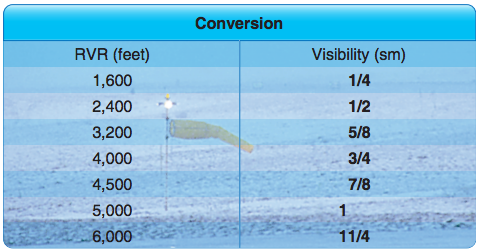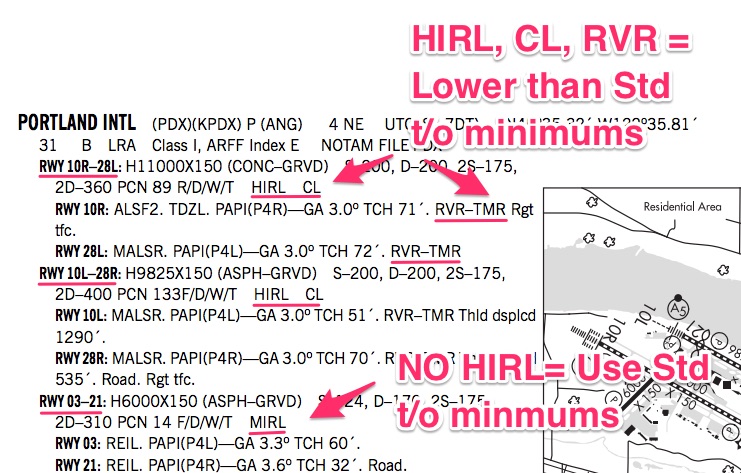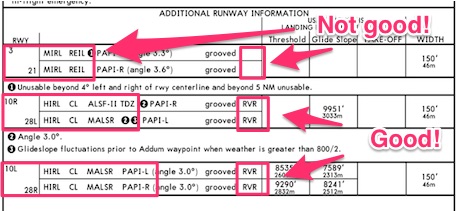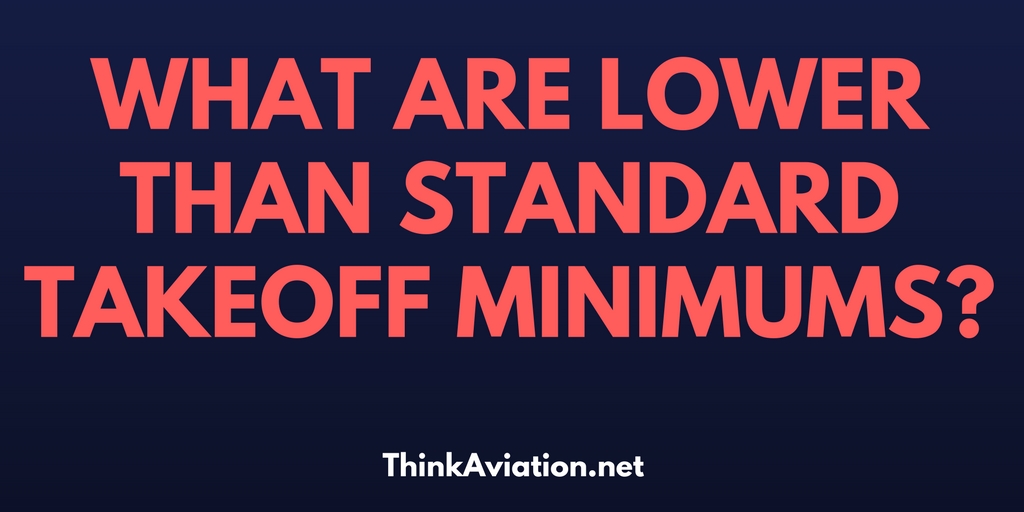We’ve all heard of standard takeoff minimums, but some Part 121 and 135 pilots have another option: lower than standard takeoff minimums.
Before I go any further, I want to make this crystal clear: Part 91 pilots, which is most general aviation pilots, do NOT have standard OR lower than standard takeoff minimums.
Part 91 pilots can take off in zero-zero conditions.
Feel free to leave this blog post if you are Part 91 pilot! Neither standards apply to you, but…
Just because you can take off in zero-zero conditions, doesn’t mean you should. If you are a Part 91 pilot, I suggest you keep reading this article and the other article I wrote about standard takeoff minimums. You should probably implement one of these standards for yourself if you want to be a safe and prudent pilot with a long career.
I suggest you implement one of these standards for yourself if you want to be a safe and prudent pilot with a long career.
As with all my articles, there are additional resources at the very bottom of the page.
Let’s start with the basics of lower than standard takeoff minimums.
Who is authorized to use lower than standard takeoff minimums?
It’s simple: Part 135 and 121 operators are only authorized to use lower than standard takeoff minimums (LSTOM) if their Operations Specifications allow them.
Where can you find the authorization for lower takeoff minimums in your OpSpec?
- Part 135: go to “C079”
- Part 121: go to “C078”
Don’t see 079 or C078 in your Opspec? You aren’t authorized to use lower than standard takeoff minimums without either C079 or C078.
In the absence of C079 or C078, you are restricted to C057 or C056 which ONLY allows you to use standard takeoff minimums (1 sm visibility up to two engines, 1/2 sm visibility for three engines or more).
I highly recommend you go and read your particular OpSpec to find out your organization’s limitations. You will find the specific limits in Table 1 and Table 2.
Note: if you don’t have anything listed in Table 2, you probably don’t have HUD capability.
Also, your General Operating Manual or Flight Operations Manual may discuss lower than standard takeoff minimums, but it’s not the official authorization from the FAA giving you permission to use lower than standard takeoff minimums (LSTOM).
Now that you know if you can do LSTOM, let’s dive into the details.
What are the RVR requirements for lower than standard takeoff minimums?
Because this is a complex answer, I highly recommend you keep a cheat sheet with you in the aircraft. You probably won’t remember the specifics when you need them.
First, if the runway has RVR, you must use the RVR. You can’t ignore the RVR report.
Second, we need to break down operations above and below 1600 RVR (1/4 sm visibility) because it’s a key line.
Above 1600 RVR:
- You only need one RVR report. The Touchdown zone (TDZ) report is controlling.
- You do have an out, though. If the TDZ report isn’t available, you can use the MID RVR.
Below 1600 RVR:
- You must have RVR below 1600 RVR. You cannot substitute visibility for RVR.
Some airports don’t have RVR systems. So, be careful. You can get down to 1/4 sm vis, but you can’t go below 1/4 statute miles visibility at airports without RVR.
Here is the conversion table for RVR and visibility:

If the NOTAM says the RVR system isn’t working at an airport that normally has RVR, or if two of the three RVR systems aren’t working, you must wait until the weather gets better.
- You must also have at least two RVR reports below 1600 RVR or 1/4sm visibility. Period.
- All three RVRs are controlling.
For example, if you are authorized to go down to 600 RVR and the TDZ and Mid say 600, but the Roll Out RVR is 300, you can’t take off.
All three RVR reports must be at or above your OpSpec’s minimums.
Note: Some larger airports like Denver have four RVR systems. The fourth, the Far End RVR, is never controlling or required. If it’s working, it can’t be counted as two of the three (TDZ, MID, ROLL OUT).
But, RVR and visibility reports are only part of the equation. To use lower than standard takeoff minimums you must also have lighting and/or runway markings.
What are the lighting and runway requirements for lower than standard takeoff minimums?
Again, we need to break it down by RVR values
When RVR is 1600 and above, ONE of the following must be present:
- High-Intensity Runway Lights (HIRL).
- Operative runway centerline (CL) lights.
- Serviceable runway centerline marking (RCLM)
If none of the above are present, then you still have an out, assuming you can still see the runway somehow.
The OpSpec C079 says: “provided other runway markings or runway lighting provide pilots with adequate visual reference to continuously identify the takeoff surface and maintain directional control throughout the takeoff roll.”
How on earth you could maintain “adequate visual reference” without some kind of lighting or runway centerline making, I have no idea, so be careful if you elect to takeoff without one of these options when the RVR is close to 1600.
Remember, a lot of heavy-use airports don’t remove runway rubber very often, so it can be very difficult to see the centerline markings.
I know at KPDX, their rubber removal machine is always broken, so it’s hard to see the center-line most of the time.
When TDZ RVR is 1200, mid-RVR 1200 (if installed), and rollout RVR 1000, may be used, provided RVR equipment and one of the following visual aid combinations are available:
(a) Daylight Hours.
- HIRL or
- Operative runway CL lights or
- Serviceable RCLM
(b) Night Time Hours.
- HIRL or
- Operative runway CL lights
When TDZ RVR is 1000, mid-RVR 1000 (if installed), and rollout RVR 1000, may be used, provided RVR equipment and one of the following visual aids combinations are available:
- Operative runway CL lights, or
- HIRL and serviceable RCLM
When TDZ RVR 600, mid-RVR 600 (if installed), and rollout RVR 600, or TDZ RVR 500, mid-RVR 500 (if installed), and rollout RVR 500, may be used, provided RVR equipment and ALL of the following visual aids are available:
- HIRL and
- Operative runway CL lights
As you can see, it gets complicated fast.
Make yourself a cheat sheet and carry it in the aircraft.
Where can you find the airport’s runway lighting on FAA and Jeppesen charts?
So, I bring this up, because you can’t take off when the RVR is below 1600 unless the runway has certain lights. But, how on earth do you make sure the runway has the right lighting system (CL lights or HIRL)?
How to find airport lighting on FAA charts:
You need to go to the Airport Flight Directory A/FD for the airport’s lighting. Check it out:

How to find airport lighting on Jeppesen charts:
The Jeppesen charts are a bit easier because they are consolidated on the Airport Diagram. Check it out for KPDX:

Four additional requirements before taking off in lower than standard conditions.
Not only do you need certain lighting systems and RVR reports to take off when the visibility is low, but there are a couple of other limitations.
1. What is a takeoff alternate and when do I need one?
You will need a takeoff alternate any time the visibility is lower than the lowest approach for that airport.
This makes sense, right? Why would you take off if you couldn’t get back to the airport you just took off from? If you lost an engine, what would you do?
The FAA wants you to plan for an emergency before you take off which is why they require a takeoff alternate.
Note: Again Part 91 pilots do not need takeoff alternates, but holy heck it’s a good idea to have one if the visibility is below the lowest usable approach!!
To figure out when you need a takeoff alternate, check out this example of an ILS in KPDX 28L.

The approach minimums require at least 2400 RVR. So, when the visibility falls below 2400 RVR or 1/2 sm, you need to file for a takeoff alternate.
Hold on, though, before you go thinking you can use a Cat III approach minimums because that’s the lowest approach at the airport, that isn’t true.
This rule is to ensure YOU can get back to the airport in an emergency. If you aren’t CAT III equipped and trained, you can’t use CAT III minimums to get around listing a takeoff alternate.
The takeoff alternate must be within one hour’s flight in still air. You don’t need to take into account current winds.
If you don’t have a viable takeoff alternate, you aren’t allowed to take off. This sometimes happens in the Pacific Northwest when both the other side of the Cascades and the coast are socked in.
2. Single Pilot operations are not permitted
This one’s self-explanatory. You need two pilots to take off with lower-than-standard takeoff minimums. And, no, you cannot use an autopilot in lieu of a second in command.
The only exception to this rule is if you are ONLY carrying cargo.
3. Requirements for Pilots in Command with less than 100 hours in the make and model.
To ensure the safety of passengers, the FAA places additional restrictions on Pilots in Command with less than 100 hours in the make and model.
With less than 100 hours in make and model, the PIC is restricted to standard takeoff minimums until they get 100 hours as a PIC in the make and model.
This also applies to a SIC when they are manipulating the controls on takeoff. They must have 100 hours in make and model to perform the takeoff in lower than standard takeoff conditions.
4. Requirements for aircraft equipped with a Heads Up Display (HUD).
This article is getting long, and I don’t want to get into aircraft with HUD. If you are one of the few operators with HUDs, please go to your OpSpec and read the requirements for HUD aircraft.
The most important thing for HUD operators to know is where to find the information in your OpSpec: C079 or C078 and pay attention to TABLE 2.
TABLE 2 will be blank for anyone who doesn’t have HUD.
Additional Resources and References:
Part 135 OpSpec C079 December 2016
14 CFR 121.651 Takeoff and landing minimums
14 CFR 91.175 Takeoff and Landing under IFR
14 CFR 135.225 IFR: Takeoff, approach and landing minimums
14 CFR 121 Takeoff alternate requirements
